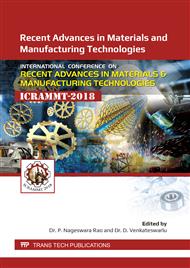[1]
M.Y. Ali, A. Banu, M. Salehan, E.Y.T. Adesta, M. Hazza, M. Shaffiq, Dimensional accuracy in dry micro wire electrical discharge machining, J. Mech. Engg. Sci. 12 (2018) 3321-3329.
Google Scholar
[2]
B. Singh, J.P. Misra, A critical review of wire electric discharge machining, DAAAM International Scientific Book, 2016, pp.249-266.
DOI: 10.2507/daaam.scibook.2016.23
Google Scholar
[3]
E.C. Jamson, Electrical Discharge Machining. Michigan: E-Publishing Inc; (2001).
Google Scholar
[4]
S. Sarkar, R. Ranjan, A. Das, Optimization of machine process parameters on material removal rate in EDM for AISI P20 tool steel material using RSM. J. Mat. Sci. Mech. Engg, 2 (2015) 117-122.
Google Scholar
[5]
V. Singh, R. Bhandari, V.K. Yadav, An experimental investigation on machining parameters of AISI D2 steel using WEDM. Int. J. Adv. Manuf. Tech. 93 (2017) 203-214.
DOI: 10.1007/s00170-016-8681-6
Google Scholar
[6]
B. Singh and J. P. Misra, Empirical modeling of average cutting speed during WEDM of gas turbine alloy, ICDME, MATEC Web of Conferences, vol. 221, 01002, (2018).
DOI: 10.1051/matecconf/201822101002
Google Scholar
[7]
B. Singh and J. P. Misra, Empirical modeling of average cutting speed during WEDM of hastelloy C22, ICMMM MATEC Web of Conferences, vol. 249, 02003, (2018).
DOI: 10.1051/matecconf/201824902003
Google Scholar
[8]
B. Singh and J. P. Misra, Empirical modelling of wear ratio during WEDM of nimonic 263, Mat. Today: Proceed., vol. 5, pp.23612-23618, (2018).
DOI: 10.1016/j.matpr.2018.10.150
Google Scholar
[9]
B. Singh and J. P. Misra, Surface finish analysis of wire electric discharge machined specimens by RSM and ANN modeling, Measurement, vol. 137, pp.225-237, (2019).
DOI: 10.1016/j.measurement.2019.01.044
Google Scholar
[10]
T. Singh, J.P. Misra, B. Singh, Experimental investigation of influence of process parameters on MRR during WEDM of Al6063 alloy, 5th Int. Conf. Mat. Proc. Charac. Mat. Today: Proceed. Hyderabad, India, 2016, p.2242–2247.
DOI: 10.1016/j.matpr.2017.02.071
Google Scholar
[11]
T. Singh, J.P. Misra, V. Upadhyay, P.S. Rao, An adaptive neuro-fuzzy inference system (ANFIS) for Wire-EDM of ballistic grade aluminium alloy, Int. J. Auto. Mech. Engg. 15 (2018) 5295-5307.
DOI: 10.15282/ijame.15.2.2018.11.0408
Google Scholar
[12]
V.K. Jain, Advanced Machining Processes, third ed., New Delhi, (2002).
Google Scholar
[13]
S.R. Gunn, M. Brown, K.M. Bossly, Network performance assessment for neuro-fuzzy data modeling, Intelligent Data Analysis, 1208 (1997) 313–323.
Google Scholar
[14]
S. Cho, S. Asfour, A. Onar, N. Kaundinya, Tool breakage detection using support vector machine learning in a milling process, Int. J. Mach. Tools Manuf. 45 (2005) 241–249.
DOI: 10.1016/j.ijmachtools.2004.08.016
Google Scholar
[15]
P. Bhattacharyya, S.K. Sanadhya, Support vector regression based tool wear assessment in face milling, In: Proceed. IEEE int. Conf. Ind. Tech. New York, 2468–2473, (2006).
DOI: 10.1109/icit.2006.372659
Google Scholar


